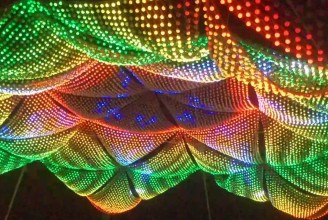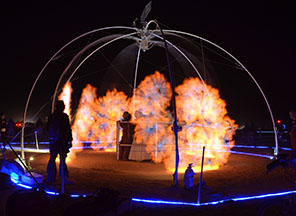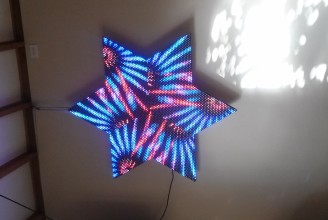In the deep playa darkness between the city and the perimeter, a wave of music slips around you. Not the constant techno undercurrent that you’re supposed to dance to, but a warm and willowy flock of woodwinds. You’re walking towards it, following it, it’s tugging at you – you’re almost floating in the night – and then you come across a conical sculpture, like the bones of a teepee, and hanging from its ceiling is the most amazing show of LED lights you’ve ever seen, transforming with the music.
The ground is a carpet of people, lying down, bundled in their coats, huddled for warmth, staring up at the ceiling, listening to the classical symphony, transported.
You take your place among them, out at the edge. Strangers take you in their arms. You can stay here for a while. Your body can rest as your soul stretches.
The piece of art is called Firmament, and was made by artist Christopher Schardt. Schardt is a long-time Burner – 19 years – who has brought an art project to nearly every one of those burns, many of which (like Char Wash and Garden of Rockets) were highly praised.

But Firmament is the piece where it all came together for him. When he set up Firmament, he was an engineer who did art; when he took it down, he was an artist who used engineering.
“A big lesson I learned is that at Burning Man the most successful art pieces aren’t just art pieces: they’re art places,” he says. “The Galleon, the Pier, or the Temple and the Man – they’re places to be. Whereas stuff that you just kind of go look at and stroke your goatee? People can like it, think it’s cool, but they always say ‘what’s next?’ pretty quickly, and they don’t go back. But art places are different, you relate to them in a whole different way, you find reasons to stay, and Firmament was the first time I’d ever created a place like that, and seeing how people reacted to that was when this difference occurred to me.”
Firmament was nothing like Schardt had originally envisioned it: he walked just as far as you did, to get there that night.
Going Beyond Fire
Schardt lives in a warehouse in Emeryville he bought with the proceeds from a programming job and spent five years fixing up to serve as a work space for artists and a home for his family. It’s all very nuts and bolts when you walk through it, filled with pipes and rods and the detritus of projects past, until you step past his private doors and into luxury – a gorgeous modern home intended to be as beautiful as it is functional. The kind of space that makes me want to devote a long chunk of my life to fixing up a warehouse on civilization’s fringe.
The first thing he tells me, when we get inside, is that the music industry broke his heart.
“I was coming out of a background of trying to be a ‘professional musician’ in the later half of the 90s, and as everybody knows that’s a very frustrating thing,” he says, settling in. “You just put your heart into it and then the recording industry comes along and says ‘eh’ you don’t look like Brittany Spears.”
He had just given up on art and turned permanently to coding when friends finally convinced him – after seven years of trying – to go to Burning Man.
“I heard about Burning Man in 1991, but I didn’t think the people telling me about it were really cool, so I didn’t go until a co-worker told me about it in 1998,” he admits sheepishly.
Burning Man didn’t just wow him with fire and lights – it showed him a place in which no one had to ask permission to do art, or struggle to have their art be welcomed into the community. After years of beating his head against the gates of the music industry, trying to be heard, the chance to simply do something and immediately be part scene was exactly what he was looking for.
By 2000 he was making large scale kinetic fire sculptures. He’s only missed one Burning Man between then and now – 2008, the year his daughter was born – and only spent one year (2009) since his first on the playa without a big art project.

He didn’t like it.
“I stayed in a big camp with a lot of friends. And had a good time. But it was a little shallow. It realized that, no: I want to be there for two weeks I want to have a challenge, I want to have something to bond to people with. People tell me they get so much more out of having a project. People don’t just want to be entertained. I mean, if it’s just one night? Sure. I’ll go for the cabaret. But if it’s a whole week ? Two? You get bored of it. You want to feel like you’re contributing. “
In 2013 he made the switch from Kinetic fire sculptures to LED art. It was mostly a practical decision: fire-art has to have somebody present to monitor it, and somebody has to refill it whenever it runs out of fuel – which is often. LED’s? Not so much. Meanwhile a friend of his had recently completed a software app for controlling complex LED set-ups. He used that, and then created his own app for the iPad (“LED Lab”) to control his new projects.

Schardt had fully transitioned from fire to light, but he was still making what he calls “gee-whiz” pieces – art that was impressive because somebody was doing it in the first place, rather than art that was itself beautiful.
“I was very much focused on the whiz-bang, isn’t this cool I can create this web of sensors and this movement, and I wasn’t focusing as much on: is it something beautiful?” he said. “Never mind interactivity for a moment: is it beautiful?”
Shooting for the Stars
Firmament was originally conceived as a gee-whiz project: one that, inspired by artist Rich DDT, would use a complicated web of sensors to follow the people underneath it and use LEDs to create “auras” of them on the screen above, and then have effects occur in the auras when two people on the ground touched.
It was doable – Rich DDT had proved it – but it was immediately problematic. “Somewhere between the LOI and actual grant application I realized that the detectors are very expensive, there’s lots of work, I’d have to make custom boxes with a custom mesh network – all this crazy stuff that I didn’t have time to do. And even if I got all the hardware together, doing things like collision detection is no mean feat.” ”
 He was beginning to wonder if he’d need to drop the project entirely when he took a hike with his father, a landscape architect.
He was beginning to wonder if he’d need to drop the project entirely when he took a hike with his father, a landscape architect.
“It’s his job to make things beautiful, as well as functional,” Schardt said, “and talking to him about this project, he kind of latched on to an aspect that I hadn’t been emphasizing, that the LED display is simply an amazing projector. And he was particularly thrilled with the idea of showing the cosmos: Hubble photographs, the aurora borealis, comets … and he looked up at the sky and said ‘You should show the entire firmament!’ … and I look at him and I realized: ‘he’s got it. He’s got a better vision for this project than I do.’”
It was a moment of transformation – both for Firmament and for Schardt. “I changed my whole alignment. I completely reoriented it for the art grant application,” saying he was going to use light and sound to make a beautiful space. The engineering would still be impressive – Firmament is made of 48 triangular panels, each panel 90 inches on a side with 450 LEDs, and every LED module need to be attached by hand, using about 1000 zip ties per panel – but engineering would be second to the aesthetics.
“I will probably never make a ‘gee-whiz, isn’t that clever’ piece again. And I’ve made a lot of them,” Schardt said. “But I think when it comes to Burning Man it’s a lot more satisfying to have a place to be.”
But Firmament is light and sound and half of it – the sound – still hadn’t come together.
“The night before I went up to the playa I stayed up until 3 a.m. on iTunes buying music, everything I could find,” he remembers. “The first day I was playing my own down tempo music … electronic music made by jazz musicians, sophisticated harmonies, always with a groove … and I thought ‘this is great, this is going to be it!’ But on Tuesday I thought I’d try the classical music I brought. And right away I could tell this was the way to go. I noticed how people would just come there and hang out and … I didn’t even need someone to tell me, I liked it so much myself, but then people did come up and tell me: ‘Oh my god, this is so great, I’ve been so needing this!”
At that moment, Firmament was complete, and no matter how cold it got it was crowded every night. A beacon on the playa.
Schardt plans to bring Firmament back to Black Rock City, with expanded capacities including true synchronization of lights to music. (Except when he was there to VJ it, this year’s edition of Firmament was in fact randomly pairing the light and music selections.) Meanwhile pieces of it have been displayed at various sites around the San Francisco Bay Area, and a long section of it is currently on display on the ceiling of the Exploratorium through Jan. 10.
 Asked what people grateful for his time, his effort, and his art can do for him, Schardt says that he’s not hurting for commissions to bring his art to parties and events – but that he very much wants to make connections in the world of fine art and galleries, connections that he didn’t make doing kinetic fire art for so many years.
Asked what people grateful for his time, his effort, and his art can do for him, Schardt says that he’s not hurting for commissions to bring his art to parties and events – but that he very much wants to make connections in the world of fine art and galleries, connections that he didn’t make doing kinetic fire art for so many years.
Somebody should hook him up. Firmament can be transcendently beautiful – that’s how I experienced it – and I can’t wait to see what his next “art place” is going to be.


I miss this piece on Playa this year (I missed seeing a lot this year, but it is a long story) saw it from a distance…
A section of it was hung at the rear of the main hall in the Bently Reserve for Artumnal Gathering this year.
I have always liked Schardt’s art pieces, I enjoy clever designs…
Report comment
Well Done Caveat Magister. Always good to see you strike another blow for beauty, hard work, and the making of magic! How I managed to miss this guy’s work every year is a mystery. Thanks for the heads up. He is in my sights now.
Report comment
Awesome piece Chris! I missed it too (thanks for putting it up here Caveat!) Maybe next year add a sun, shooting star or rocket… could always find your fire spouting pieces.
Report comment
2015 was my first burn and I luckily stumbled across this on one of the coldest nights. As I took my place among the “carpet of people,” I rested and gained temporary relief from the cold.. Not only from the body heat of those around me but also because the bright and colorful lights with calm music created a sense of warmth. It was an oasis! Very memorable experience! Thank you!
Report comment
Comments are closed.